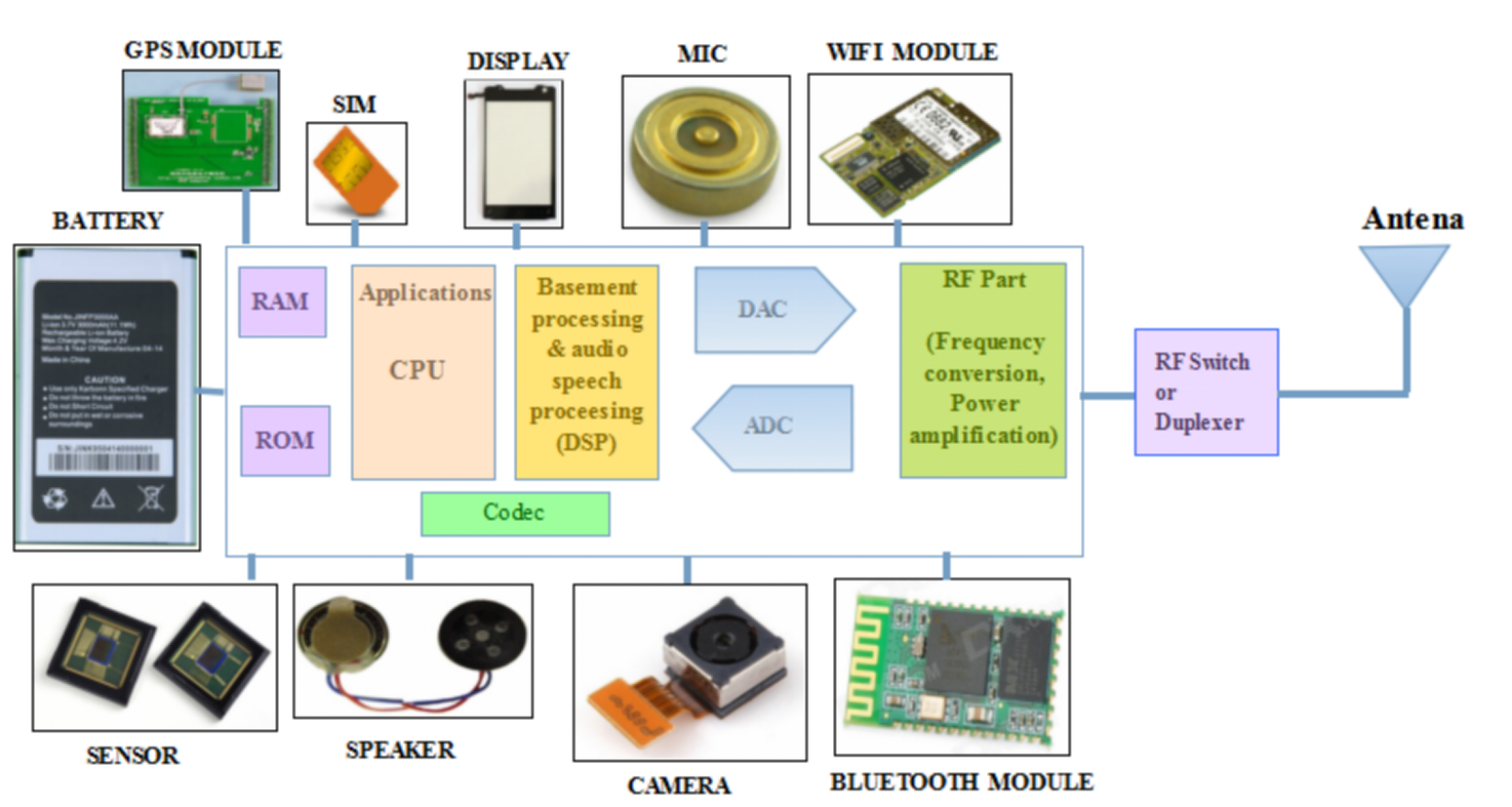Mobile Phone Architecture
When we say a mobile, it is not just a piece of plastic/metallic body, as it looks from outside, there are lots of different components/modules inside that mobile. This article covers basics of mobile phone internal components/modules.
Typically Mobile phone will have display (LCD, touch screen), keypad, microphone, speaker, SIM card, battery, USB port, antenna, memory unit(RAM,ROM), camera, CODEC, RF part, DAC/ADC, baseband part (L1/Layer1/physical layer) running on DSP, Application/protocol layers running on CPU, ON/OFF switch and Bluetooth/GPS features. All these features are based on specific standard specifications designed, like it may be based on GSM, WCDMA or LTE etc.
Lets put some light on individual parts of mobile phone.
RF Part:
As shown in figure above, every phone will have RF part which consists of RF frequency up converter and rf frequency down converter, many analog filters, digital attenuator (whose attenuation is controlled digitally), driver amplifiers etc. For system, up converter converts modulated baseband signal(I and Q) either at zero IF(Intermediate frequency) or some IF to RF frequency. RF down converter converts RF signal to baseband signal(I and Q). The basic component used for frequency conversion is RF mixer. Analog filters pass only desired band of signals. Amplifiers boost up the signal to the required transmit power level.
Baseband Part:
Baseband part in a mobile is comprised of a digital signal processor (DSP) to process forward voice/data signals for transmission and to process reverse voice/data signals received.
This is the core processing part which changes for various air interface standards like GSM, HSPA, LTE and more. It is often named as physical layer or Layer 1 or L1. For Speech/audio, codec is used to compress and decompress the signal to match the data rate to the frame it has to fit in. The baseband or physical layer will add redundant bits to enable error detection as well as error correction. Error detection is obtained with CRC and error correction with forward error correction techniques. Other than this interleaving is done for the data of one burst which helps in spreading the error over the time hence helps receiver de-interleave and decode the frame (consecutively data burst) correctly.
ADC and DAC:
ADC(Analog to Digital Converter) and DAC(Digital to Analog Converter) is used to convert analog speech signal to digital signal and vice versa in the mobile handset.
RF Switch / Duplexer:
RF switch is used for TDD configuration, which switches the RF path between transmit chain and receive chain and on the other side, Duplexer is used for FDD configuration which passes the transmitted signal and received signal at the same time through it. Like GSM 900MHz in India is FDD, so Duplexer is used there and LTE Band 40 is TDD in India, RF switch is used there.
Application layer
It consists of protocols that focus on process-to-process communication across an IP network and provides a firm communication interface and end-user services. It also runs on CPU. It include audio,video and image/graphics applications. The application layer provides many services, including:Simple Mail Transfer, Protocol File transfer, graphics etc.
Camera
Now-a-days with almost all the mobile phone camera feature is available for one to click pictures at various occasions. It is the major specifications in increasing cost of mobile phone. There are various mega pixel camera for mobile phones are available such as 5 mega pixel, 13 mega pixel and even 41 mega pixel available in smartphones. This has become evident because of advancement in sensor technology.
Display
There are lot of display types used in mobile phones. They can be either color or monochrome. The color displays usually are CSTN, TFT, TFD or OLED with a predominant use of TFT displays in current mobile lineups. There are also two types of touchscreen displays – capacitive and resistive, which are both based on TFT technology.
CAPACITIVE touchscreens work by sensing the electrical properties of the human body, while RESISTIVE ones operate by sensing direct pressure applied by the user.
The RESISTIVE type can be activated by pressing not only with human skin but also with a stylus and thus allow handwriting recognition input.
Microphone
Microphone or mic converts air pressure variations(result of our speech) to electrical signal to couple on the PCB for further processing. Usually in mobile phone mic of types condenser,dynamic,carbon or ribbon is used.
Speaker
It converts electrical signal to audible signal(pressure vibrations) for human being to hear. This is often coupled with audio amplifier to get required amplification of audio signal. It also tied with volume control circuit to change(increase or decrease) the amplitude of the audio signal.
Antenna
An antenna converts electromagnetic radiation into electric signal and vice versa. In mobile phone, antenna is embedded inside, which is not visible to us. A metal strip pattern is served as an antenna.
Connectivity(WiFi, Bluetooth, USB, GPS)
To make data transfer fast enough between mobile phone and other computing devices(laptop,desktop,tablet) or between mobile and mobile various technologies are evolved which include WiFi, Bluetooth, USB. GPS(global positioning system) is used for location assistance and will enable google map to work efficiently.
Sensors
A sensor is a transducer whose purpose is to sense (that is, to detect) some characteristic of its environs. It detects events or changes in quantities and provides a corresponding output, generally as an electrical or optical signal. In mobile phone, there are various kind of sensors are used like accelerometer, magnetometer, proximity sensor, light sensor, barometer, padometer, thermometer etc.
Various mobile phones have different concepts and design on every aspects, but the methods and operational flow are all exactly the same. It differs on how and what certain IC chips and parts they are being used and installed to a certain mobile phone circuitry.





